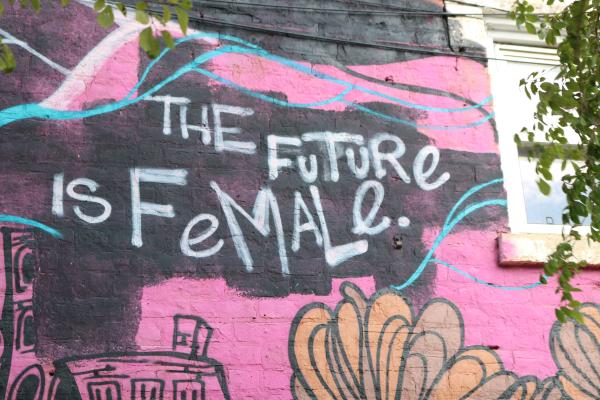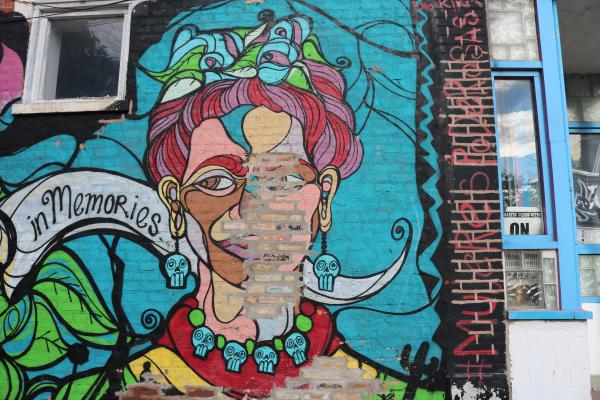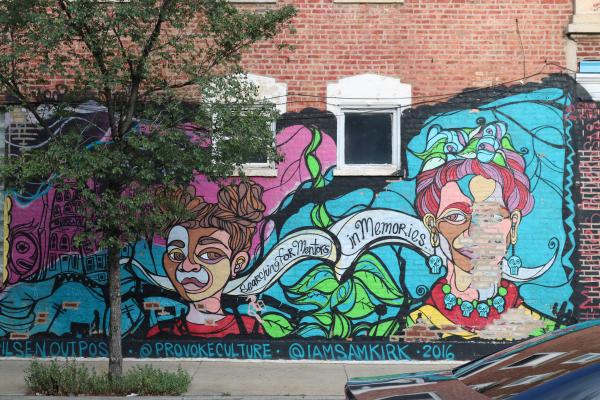Searching for Mentors in Memories
artists
Samantha Kirk
location
W. 21st Street and S. Damen Avenue
Themes: work, cityscape
Multidisciplinary artist Sam Kirk bases her family’s movement in and around the city of Chicago during her childhood as the spark for her affinity for studying “the nuances of the human experience.” Her work in the mural “Searching for Mentors in Memories” demonstrates the particular experience of the woman in the world.
The mural was made as part of the Mujeres Poderosas Exhibit at Pilsen Outpost in 2016. Kirk’s website describes the piece’s purpose as discussing the need for more living female artists as icons in the industry. While the assumed industry is the art world, the universality of this mural and of Kirk’s work in general allows for interpretation of industry as much more like society in general. Kirk herself is a mujer poderosa — a powerful woman — as her work seeks to both discuss culture in Pilsen and around Chicago while also exploring ideas of sexuality, race, and gender roles.
Kirk’s life as a biracial, queer woman motivates her personally. She uses the power and platform she has created for her murals to vibrantly demonstrate a world that encourages powerful women and men alike to be their most authentic selves. Additionally, her work asks its audience members to speak their truths loudly and colorfully, even in the quietest and dullest environments.
“Searching for Mentors in Memories” features a vibrant teal-blue background with two female figures in the typical broad stroke, cartoon-esque color palette style of Sam Kirk: Frida Kahlo and a young girl next to her, looking at each other. The young girl’s skin sections are colored various shades of tan, pink, and brown — these are all a nod to the biracial experience Kirk and many others and Pilsen live. By using colors like red and pink for Kahlo’s hair compared to brown hair for the young girl, there is a notion that youth following and learning from their mentors will guarantee them the vibrancy and bold life they desire. The words “Dreams” and “The future is female” are written in spray paint next to the young girl, emphasizing the efforts trying to be achieved for women through the mural. The nod toward dreams and the future is interestingly paired with the acknowledgment of memory and the past, which is shown in the title and in the middle of the piece.
Time is an important element of this mural, as a conscious knowledge of the past is needed in order for growth, but hope and aspiration for the future must be thought of in tandem with this. Frida appears as a more adorned, vibrant version of the young girl, symbolizing the growth and admiration that exists between youth and mentor.
The mural itself has peeled along much of the right half of Frida’s face despite the fact that it was only done three years ago. While this was probably due to weather and time, the fact that Frida still shines through the cracks in the wall and the peeled paint symbolize that she has still surfaced despite adversity and hardship, setting a model for the young girl next to her.
In many ways, this mural speaks to more than just women. People of all walks can seek to learn from their mentors and their memories. Kirk claims that all of her artwork seeks to identify how life experiences impact identity, and thus this piece appeals to anyone dreaming of something greater, looking to the past to make a better future.





